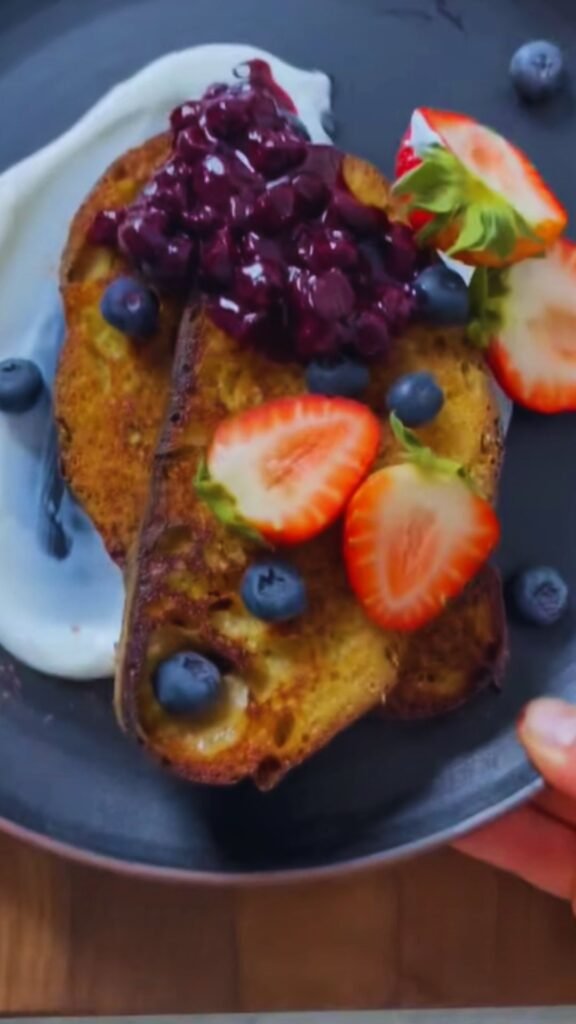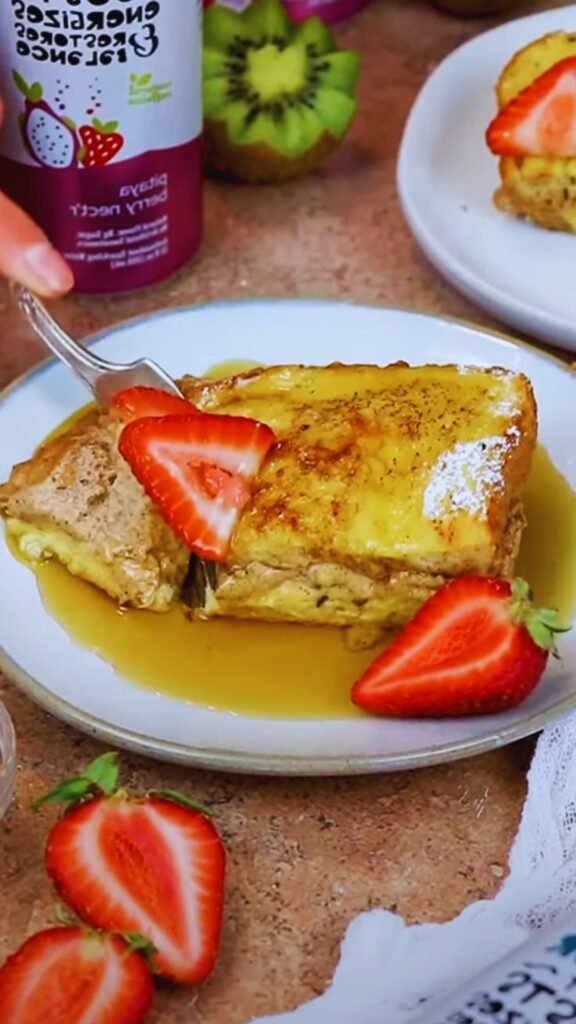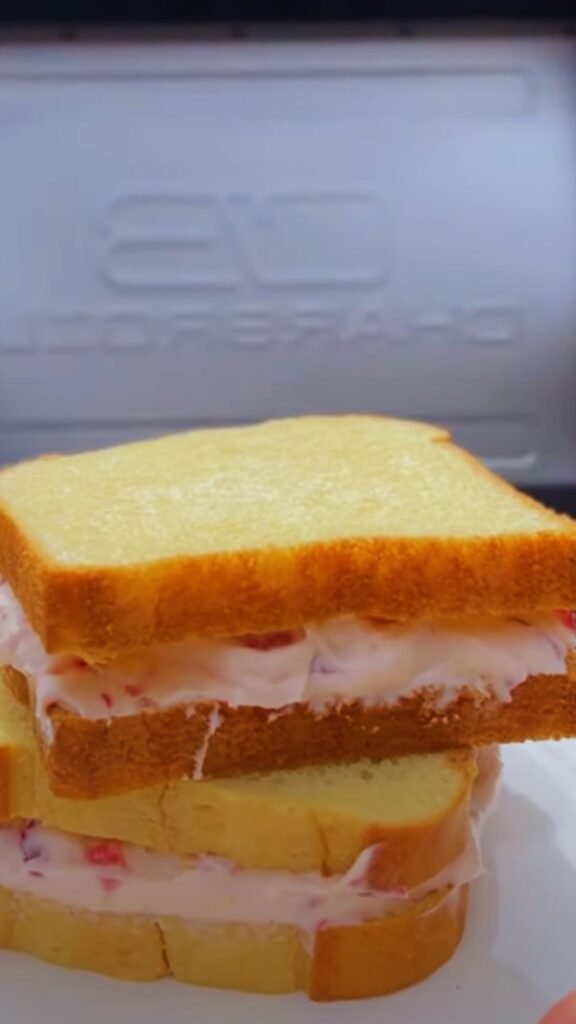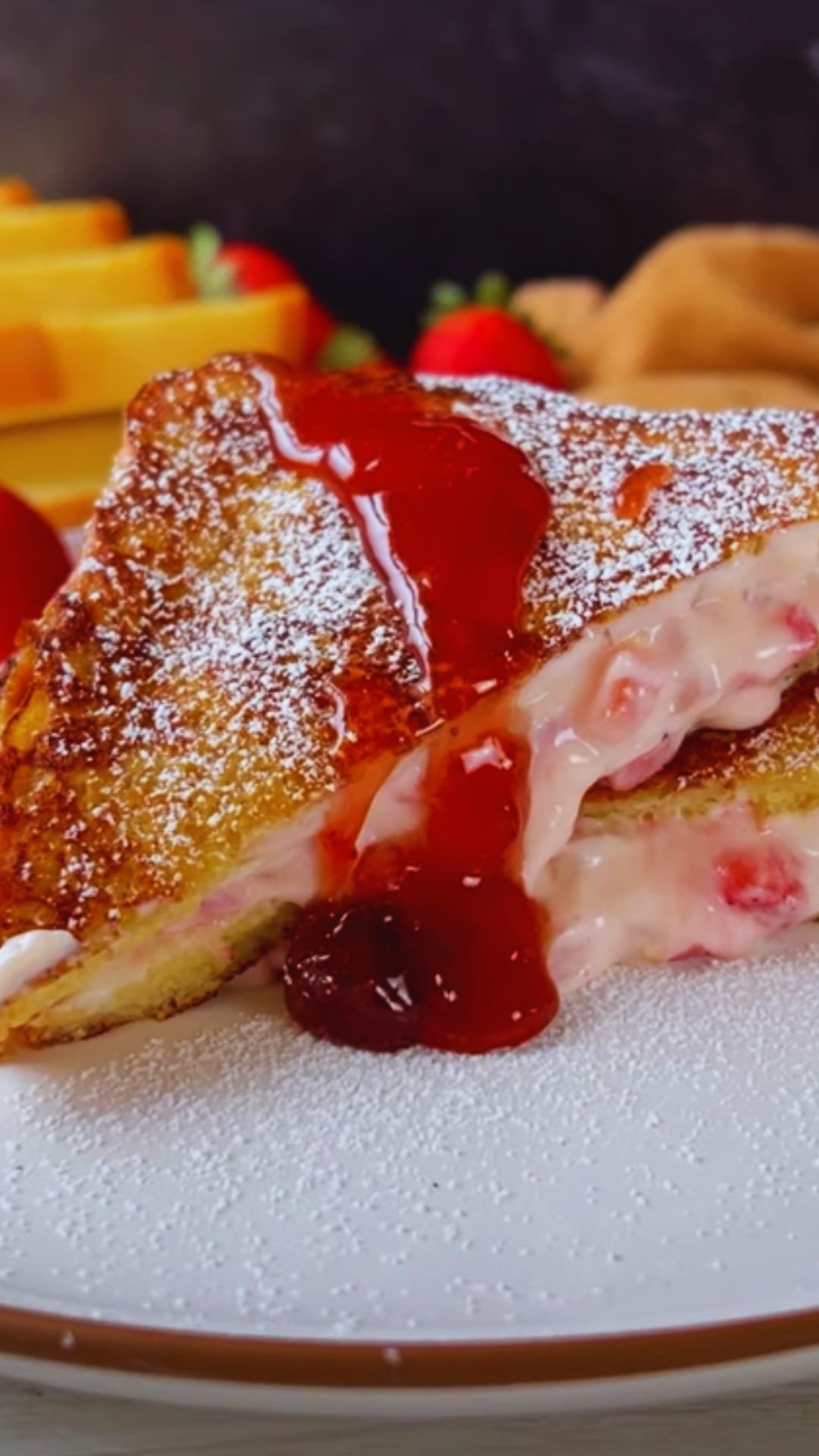There’s something magical about waking up to the aroma of French toast sizzling in butter. But when you add a sunshine burst of lemon cream filling? That’s when breakfast becomes an event worth climbing out of bed for. I’ve been making French toast for years, but this lemon cream stuffed version has become my weekend signature—the dish friends request when they come over for brunch.
Let me tell you, I wasn’t always a breakfast person. Most mornings used to be a hurried affair of grabbing whatever was quickest before rushing out the door. But after discovering how transformative a proper breakfast can be (and honestly, how much money I was wasting on mediocre café breakfasts), I started experimenting with recipes that would make mornings something to look forward to without breaking the bank.
This lemon cream stuffed French toast hits all the right notes—it’s indulgent yet light, sweet but tangy, and looks impressive despite being surprisingly simple to make. The contrast between the crisp, golden exterior and the creamy, bright lemon filling creates a perfect balance that will have you scraping your plate clean.
The Beauty of Budget-Friendly Indulgence
When I first started getting serious about cooking at home to save money, I worried that “budget cooking” meant saying goodbye to anything that felt special. I couldn’t have been more wrong. This lemon cream stuffed French toast uses simple, affordable ingredients—bread that might even be slightly stale (perfect for French toast!), eggs, milk, and a few other pantry staples. The magic is in how these humble ingredients transform into something that feels restaurant-worthy.
What makes this recipe particularly wallet-friendly is its versatility. You can use whatever bread you have on hand—whether it’s a French baguette approaching staleness, regular sandwich bread, or challah if you’re feeling fancy. The lemon cream filling uses basic ingredients elevated with zest and juice from fresh lemons, which are generally inexpensive year-round.
Ingredients You’ll Need
For the Lemon Cream Filling:
- 8 oz cream cheese, softened (budget tip: store brands work perfectly)
- 1/4 cup granulated sugar
- Zest of 2 lemons
- 3 tablespoons fresh lemon juice
- 1 teaspoon vanilla extract
- Pinch of salt
For the French Toast:
- 8 thick slices of bread (day-old bread works best)
- 4 large eggs
- 1/2 cup milk
- 1/4 cup heavy cream (can substitute with more milk if needed)
- 2 tablespoons granulated sugar
- 1 teaspoon vanilla extract
- 1/2 teaspoon ground cinnamon
- Pinch of salt
- 3 tablespoons butter for cooking (plus more as needed)
For Serving:
- Powdered sugar for dusting
- Fresh berries (whatever’s in season and on sale)
- Maple syrup or honey
- Fresh mint leaves for garnish (optional)

Equipment Needed
One of the reasons I love this recipe is that it doesn’t require any specialized equipment:
- Medium mixing bowl
- Electric mixer (a hand mixer works fine, or even just a whisk and some arm strength)
- Shallow dish for the egg mixture
- Non-stick skillet or griddle
- Spatula
- Knife for creating pockets in the bread
- Measuring cups and spoons
Step-by-Step Instructions
Preparing the Lemon Cream Filling
- Place the softened cream cheese in a medium mixing bowl and beat until smooth and fluffy. (I like to leave my cream cheese out for at least 30 minutes before starting to ensure it’s properly softened—cold cream cheese will leave you with lumps.)
- Add the sugar and beat until well combined and the mixture lightens in texture.
- Mix in the lemon zest, lemon juice, vanilla extract, and pinch of salt. Beat until everything is fully incorporated and the mixture is smooth and creamy.
- Taste and adjust—if you want it tangier, add a bit more lemon juice; if you prefer it sweeter, add a touch more sugar.
- Set aside while you prepare the egg mixture. (You can make this filling a day ahead and refrigerate it, just let it come back to room temperature before using so it spreads easily.)
Making the French Toast Egg Mixture
- In a shallow dish, whisk together the eggs, milk, heavy cream, sugar, vanilla extract, cinnamon, and salt until thoroughly combined.
- The mixture should be smooth with no visible egg whites floating around. This ensures an even coating on your bread.
Stuffing and Cooking the French Toast

- Using a sharp knife, cut a pocket into each slice of bread. Start at the top crust and carefully slice horizontally through the middle of the bread, stopping before you cut all the way through. You want to create a pocket while keeping the bread intact on three sides.
- Spoon or pipe about 2 tablespoons of the lemon cream filling into each pocket. Don’t overfill or the filling will ooze out during cooking. Gently press the edges of the bread together to seal in the filling.
- Heat a non-stick skillet or griddle over medium heat. Add 1 tablespoon of butter and let it melt, swirling to coat the surface.
- Dip each stuffed bread slice into the egg mixture, allowing it to soak for about 20-30 seconds per side. If your bread is very fresh, a quick dip will do; if it’s stale, give it a bit more time to soak up the mixture.
- Place the soaked bread in the hot skillet (don’t crowd the pan—work in batches of 2-3 slices depending on your pan size). Cook for 3-4 minutes on each side, or until golden brown and cooked through.
- Add more butter to the pan between batches as needed.
- Transfer the cooked French toast to a plate and keep warm in a low oven (about 200°F) while you finish cooking the remaining slices.
Serving Suggestions
- Arrange the French toast on plates (2 slices per serving is usually perfect).
- Dust generously with powdered sugar—I like to use a small sieve for this to get an even, light coating.
- Top with fresh berries—strawberries, blueberries, and raspberries all pair beautifully with the lemon flavor.
- Offer maple syrup or honey on the side, though many times I find the lemon cream and berries provide enough sweetness on their own.
- Garnish with fresh mint leaves for a pop of color and complementary flavor.
- For an extra-special touch, serve with a dollop of whipped cream or a spoonful of Greek yogurt.

Recipe Variations to Keep Things Interesting
The beauty of this recipe is how adaptable it is. Here are some variations I’ve tried when I want to switch things up:
- Berry Lemon: Fold 1/2 cup of fresh berries into the lemon cream filling for bursts of fruit throughout.
- Citrus Medley: Replace half the lemon juice and zest with orange or lime for a more complex citrus flavor.
- Mascarpone Magic: Substitute mascarpone cheese for cream cheese for an even richer, more delicate flavor.
- Coconut Dream: Add 1/4 cup toasted coconut flakes to the filling and sprinkle more on top for a tropical twist.
- Ginger Zing: Mix 1 teaspoon finely grated fresh ginger into the lemon cream for a warming, spicy note.
- Honey Lemon: Replace the granulated sugar with honey in the filling for a more complex sweetness that complements the lemon beautifully.
Money-Saving Tips
Being budget-conscious doesn’t mean skimping on flavor. Here are my favorite ways to make this dish even more wallet-friendly:
- Use day-old bread: French toast was originally created as a way to use up stale bread, so don’t feel the need to buy fresh. Check the discount rack at your bakery for marked-down loaves.
- Freeze leftover filling: If you make extra lemon cream filling, it freezes beautifully for up to a month. Thaw overnight in the refrigerator for future French toast adventures.
- Shop seasonally for garnishes: While berries are my favorite topping, use whatever fruits are in season and on sale. Peaches in summer, apples in fall, and citrus segments in winter all work wonderfully.
- Make your own vanilla extract: If you bake often, consider making your own vanilla extract by soaking vanilla beans in vodka. The initial investment pays off over time.
- Buy lemons in bulk: When they’re on sale, buy extra and freeze the juice and zest in ice cube trays for future use.
Nutritional Information
For those keeping an eye on nutritional content, here’s a breakdown per serving (2 slices):
| Nutrient | Amount |
|---|---|
| Calories | 520 |
| Total Fat | 32g |
| Saturated Fat | 18g |
| Cholesterol | 240mg |
| Sodium | 520mg |
| Total Carbohydrates | 46g |
| Dietary Fiber | 2g |
| Sugars | 22g |
| Protein | 14g |
| Vitamin D | 12% DV |
| Calcium | 15% DV |
| Iron | 15% DV |
| Potassium | 8% DV |
Make-Ahead Options
Busy mornings shouldn’t stop you from enjoying this special breakfast. Here are some ways to prep ahead:
- The lemon cream filling can be made up to 3 days in advance and stored in an airtight container in the refrigerator.
- You can prepare the egg mixture the night before and store it covered in the refrigerator.
- For a grab-and-go option, cook the French toast completely, let cool, then wrap individual portions in plastic wrap and freeze for up to a month. Reheat in a toaster or oven when ready to enjoy.
Troubleshooting Common Issues
Even experienced cooks encounter challenges. Here are solutions to common French toast problems:
- Soggy centers: If your French toast is golden on the outside but soggy inside, your heat is likely too high. Lower the temperature and cook a bit longer.
- Filling leaking out: Too much filling or not sealing the edges properly can cause leakage. Use less filling and gently press the edges together before dipping in the egg mixture.
- Burning too quickly: If your French toast is burning before cooking through, your pan is too hot. Reduce the heat and add a bit more butter to prevent sticking.
- Lemon filling too tart: Balance excessive tartness by adding a bit more sugar or a drizzle of honey to the filling.
- Bread falling apart: Very fresh bread can be too soft for stuffing. Either use day-old bread or lightly toast fresh bread before cutting the pocket.
Why This Recipe Works
The science behind perfect French toast is fascinating. The egg proteins in the soaking mixture coagulate when heated, creating that delicious custard-like interior. Meanwhile, the Maillard reaction between the milk proteins and sugars gives us that beautiful golden-brown exterior.
The lemon and cream cheese filling works so well because the tangy acidity of the lemon cuts through the richness of the cream cheese and egg mixture, creating a balanced flavor profile that prevents the dish from becoming overly heavy or sweet.
Q&A Section
Q: Can I use gluten-free bread for this recipe? A: Absolutely! Just choose a sturdy gluten-free bread that won’t fall apart when soaked. You may need to adjust the soaking time—gluten-free breads sometimes need less time in the egg mixture to prevent crumbling.
Q: I’m lactose intolerant. Can I still make this? A: Yes! Look for lactose-free cream cheese and use a plant-based milk like almond or oat milk in the egg mixture. The results will be slightly different but still delicious.
Q: How do I know when the French toast is cooked through? A: The exterior should be golden brown and slightly crisp, and the center should feel set rather than squishy when gently pressed. If you’re concerned, you can check that the internal temperature has reached 165°F, which ensures the eggs are fully cooked.
Q: Can I make this recipe without eggs? A: You can create an egg-free version by substituting the egg mixture with 1 cup of plant milk mixed with 2 tablespoons of cornstarch, 1 tablespoon of nutritional yeast (for flavor), and the same spices. The texture will be different, but still enjoyable.
Q: My lemon cream filling is lumpy. What did I do wrong? A: The most common cause is cream cheese that wasn’t soft enough. Make sure it’s at room temperature before beating. If you’re in a hurry, unwrap it and microwave in 10-second bursts until softened but not melted.
Q: Is there a way to make this healthier? A: Several options! Use whole grain bread for more fiber, substitute some of the cream cheese with Greek yogurt, reduce the sugar, and use egg whites in place of some whole eggs. These changes will alter the flavor and texture somewhat but will reduce calories and increase nutritional value.
I’ve found that cooking isn’t just about following recipes—it’s about understanding how ingredients work together and making adjustments based on what you have and what you like. This lemon cream stuffed French toast has become one of my signature dishes not because I follow the recipe exactly the same way every time, but because I’ve learned how to adapt it to whatever my kitchen and budget allow.
The next time you find yourself with a loaf of bread that’s just past its prime, don’t toss it! Transform it into this delightful breakfast that tastes like sunshine on a plate. Your wallet—and your taste buds—will thank you.


